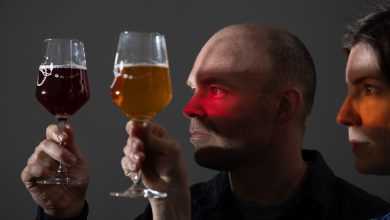Omicron’s Radical Evolution

As nurses and doctors struggle with a record-breaking wave of Omicron cases, evolutionary biologists are engaged in a struggle of their own: figuring out how this world-dominating variant came to be.
When the Omicron variant took off in southern Africa in November, scientists were taken aback by its genetic makeup. Whereas earlier variants had differed from the original Wuhan version of the coronavirus by a dozen or two mutations, Omicron had 53 — a shockingly large jump in viral evolution.
In a study posted online last week, an international team of scientists further deepened the mystery. They found that 13 of those mutations were rarely, if ever, found in other coronaviruses, suggesting they should have been harmful to Omicron. Instead, when acting in concert, these mutations appear to be key to some of Omicron’s most essential functions.
Now the researchers are trying to figure out how Omicron defied the normal rules of evolution and used these mutations to become such a successful vector of disease.
“There’s a mystery here that someone has to figure out,” said Darren Martin, a virologist at the University of Cape Town who worked on the new study.
Mutations are a regular part of a coronavirus’s existence. Every time a virus replicates inside of a cell, there’s a small chance that the cell will create a flawed copy of its genes. Many of those mutations would make new viruses defective and unable to compete with other viruses.
But a mutation can also improve a virus. It could make the virus stick more tightly to cells, for example, or make it replicate faster. Viruses that inherit a beneficial mutation may outcompete others.
Over most of 2020, scientists found that different lineages of the coronavirus around the world gradually picked up a handful of mutations. The evolutionary process was slow and steady, until the end of the year.
In December 2020, British researchers were jolted to discover a new variant in England carrying 23 mutations not found in the original coronavirus isolated in Wuhan a year before.
That variant, later named Alpha, soon swept to dominance worldwide. Over the course of 2021, other fast-spreading variants emerged. While some remained limited to certain countries or continents, the Delta variant, with 20 distinctive mutations, ousted Alpha and became dominant over the summer.
And then came Omicron, with over twice as many mutations. As soon as Omicron came to light, Dr. Martin and his colleagues set about reconstructing the variant’s radical evolution by comparing its 53 mutations with those of other coronaviruses. Some mutations were shared by Omicron, Delta and other variants, suggesting that they had arisen several times, and that natural selection had favored them over and over again.
But the scientists found a very different pattern when they looked at the “spike” protein that studs Omicron’s surface and allows it to latch on to cells.
Omicron’s spike gene has 30 mutations. The researchers found that 13 of them were extraordinarily rare in other coronaviruses — even their distant viral cousins found in bats. Some of the 13 had never been seen before in the millions of coronavirus genomes scientists have sequenced over the course of the pandemic.
If a mutation were beneficial to the virus, or even neutral, scientists would expect it to show up more often in the samples. But if it is rare or missing altogether, that’s typically a sign that it is harmful to the virus, preventing it from multiplying.
“When you see that pattern, it’s telling you something very loud and very clear,” Dr. Martin said. “Anything that sustains a change at those sites is probably going to be defective and isn’t going to survive for very long and will die out.”
And yet Omicron was flouting that logic. “Omicron wasn’t exactly dying out,” Dr. Martin said. “It was just taking off like nothing we’d ever seen before.”
What makes these 13 mutations all the more intriguing is that they’re not randomly sprinkled across Omicron’s spike. They form three clusters, each altering a small portion of the protein. And each of those three areas play a big part of what makes Omicron unique.
Two of the clusters change the spike near its tip, making it harder for human antibodies to stick to the virus and keep it out of cells. As a result, Omicron is good at infecting even people who have antibodies from vaccinations or a previous Covid infection.
The third cluster of mutations alters the spike closer to its base. This region, known as the fusion domain, swings into action once the tip of the spike has hooked onto a cell, enabling the virus to deliver its genes inside its new host.
Typically, coronaviruses use the fusion domain to merge with a cell’s membrane. Their genes can then float away into the depths of the cell.
But Omicron’s fusion domain usually does something different. Rather than merging into the cell membrane, the whole virus gets swallowed up in a kind of cellular sink hole, which pinches off to form a bubble inside the cell. Once the virus is captured inside the bubble, it can break open and release its genes.
This new pathway to infection may help to explain why Omicron is less severe than Delta. The cells in the upper airway can readily swallow up Omicron in bubbles. But deep in the lungs, where Covid can cause life-threatening damage, coronaviruses have to fuse to cells, which Omicron doesn’t do well.

The Coronavirus Unveiled
Scientists around the world have captured detailed images of the coronavirus.
These three regions of the spike seem to have been important for Omicron’s success. This makes it all the more puzzling that these 13 mutations were so vanishingly rare before Omicron.
The Coronavirus Pandemic: Key Things to Know
Omicron in retreat. Though the U.S. is still facing overwhelmed hospitals and more than 2,000 deaths a day, encouraging signs are emerging as new cases start to fall nationally. The World Health Organization said the variant offered “plausible hope for stabilization.”
New York mask mandate. An appeals court judge granted a motion by the New York attorney general to temporarily block a lower-court ruling that had struck down the state’s mask mandate. The rule, which was renewed by Gov. Kathy Hochul in December and currently remains in effect, required masks or proof of vaccination at all indoor public places.
Around the world. The European Union recommended that residents traveling within the bloc who have been vaccinated or have recovered from the virus should not face additional restrictions like testing or quarantine. In China, officials reported a case within a bubble set up to insulate Olympic participants from the rest of the country.
Staying safe. Worried about spreading Covid? Keep yourself and others safe by following some basic guidance on when to test, which mask to pick and how to use at-home virus tests. Here is what to do if you test positive for the coronavirus.
Dr. Martin and his colleagues suspect the reason is “epistasis”: an evolutionary phenomenon that can cause mutations to be harmful on their own, but beneficial when combined.
Omicron may have turned a batch of 13 bad mutations to its advantage by evolving under unusual conditions. One possibility is that it arose after a sustained period inside the body of a person with an especially weak immune system, such as an H.I.V. patient. People with chronic Covid infections can become evolutionary laboratories, hosting many generations of coronaviruses.
Evolution can play out very differently in such a host than it would hopping from one healthy person to another every few days or weeks.
“Now it’s stuck in this one individual, so all of a sudden it’s doing things that it normally wouldn’t do,” said Sergei Pond, an evolutionary biologist at Temple University and an author of the new study.
Because an immunocompromised host doesn’t produce a lot of antibodies, many viruses are left to propagate. And new mutant viruses that resist the antibodies can multiply.
A mutation that allows a virus to evade antibodies isn’t necessarily advantageous. It could make the virus’s spike protein unstable so that it can’t latch quickly onto a cell, for example. But inside someone with a weak immune system, viruses may be able to gain a new mutation that stabilizes the spike again.
Similar mutations could have built upon themselves again and again in the same person, Dr. Pond speculates, until Omicron evolved a spike protein with just the right combination of mutations to allow it to spread supremely well among healthy people.
“It certainly seems plausible,” said Sarah Otto, an evolutionary biologist at the University of British Columbia who was not involved in the study. But she said scientists still needed to run experiments to rule out alternative explanations.
It’s possible, for example, that the 13 spike mutations offer no benefit to Omicron at all. Instead, some of the other spike mutations could be making Omicron successful, and the 13 are just along for the ride.
“I would be cautious about interpreting the data to indicate that all of these previously deleterious mutations have been adaptively favored,” Dr. Otto said.
Dr. Pond also acknowledged that his hypothesis still has some big gaps. For example, it’s not clear why, during a chronic infection, Omicron would have gained an advantage from its new “bubble” method for getting into cells.
“We just lack imagination,” Dr. Pond said.
James Lloyd-Smith, a disease ecologist at U.C.L.A. who was not involved in the study, said that the research revealed just how hard it is to reconstruct the evolution of a virus, even one that arose recently. “Nature is certainly doing its part to keep us humble,” he said.



